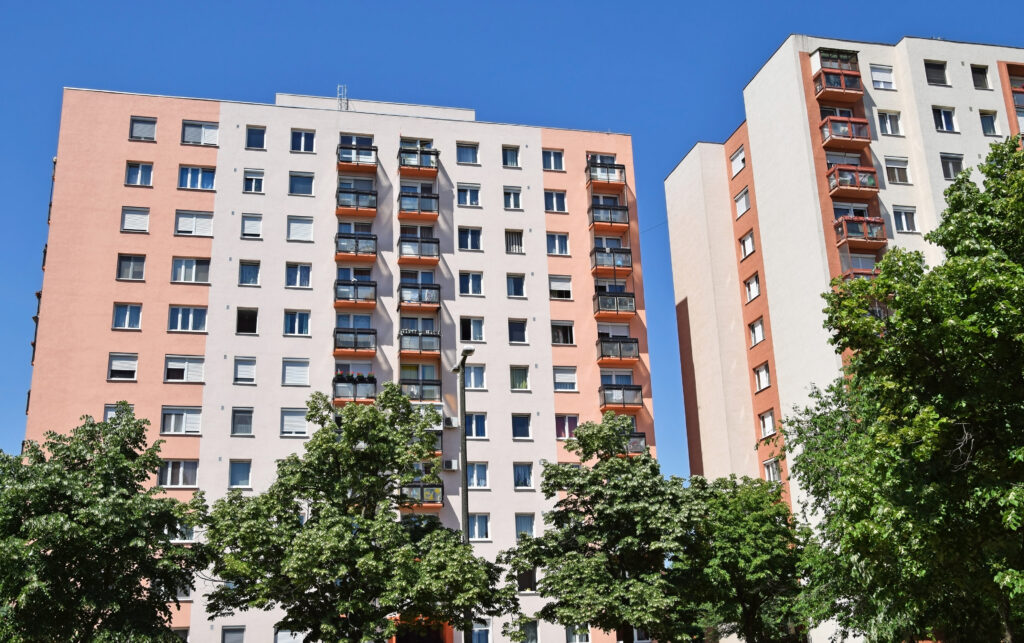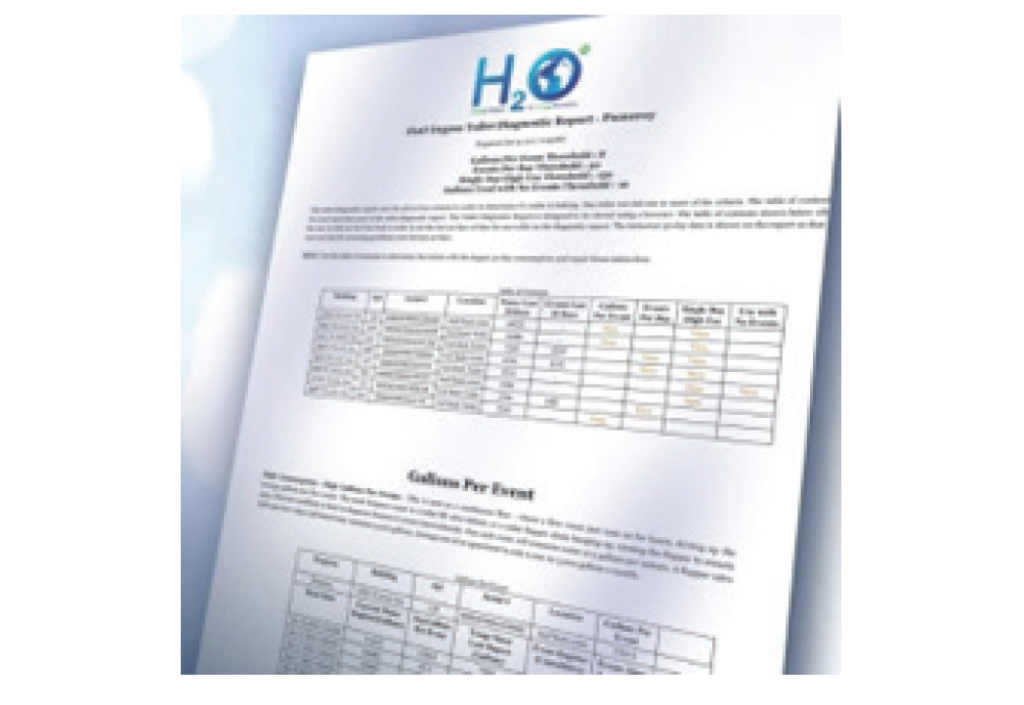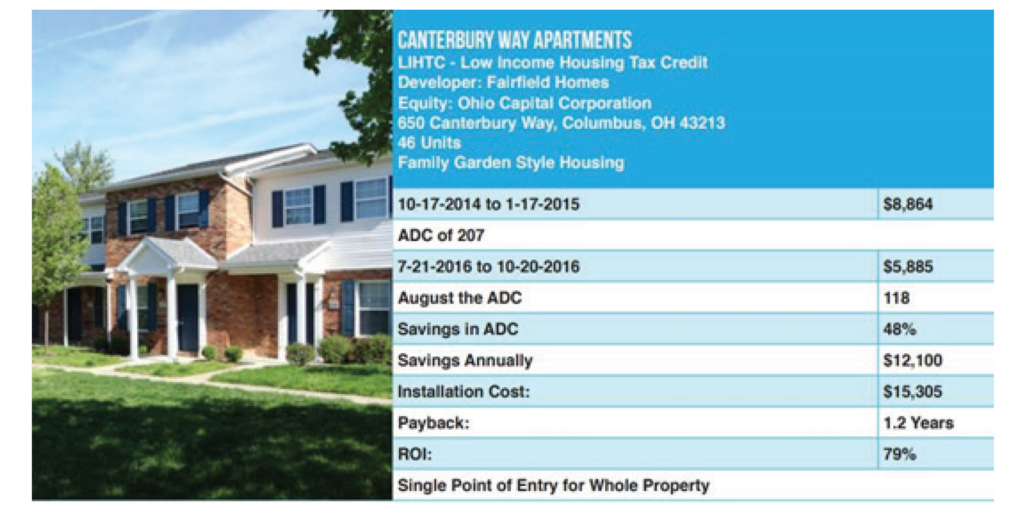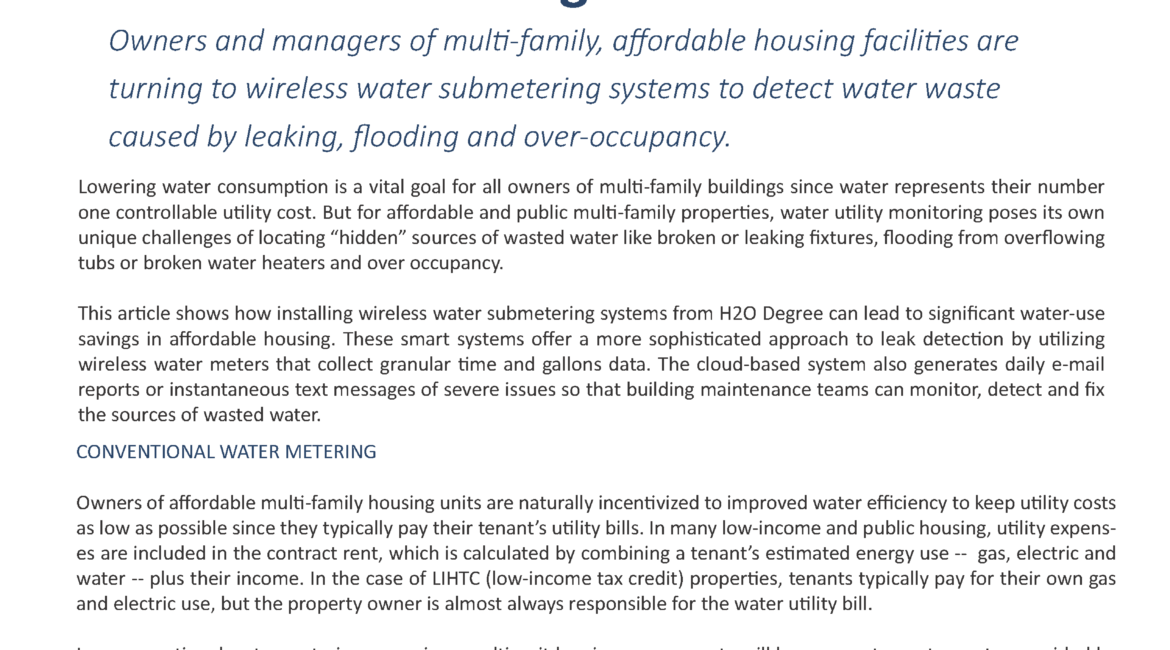Owners and managers of multi-family, affordable housing facilities are
turning to wireless water submetering systems to detect water waste
caused by leaking, flooding and over-occupancy.

Lowering water consumption is a vital goal for all owners of multi-family buildings since water represents their number one controllable utility cost. But for affordable and public multi-family properties, water utility monitoring poses its own unique challenges of locating “hidden” sources of wasted water like broken or leaking fixtures, flooding from overflowing tubs or broken water heaters and over occupancy.
This article shows how installing wireless water submetering systems from H2O Degree can lead to significant water-use savings in affordable housing. These smart systems offer a more sophisticated approach to leak detection by utilizing wireless water meters that collect granular time and gallons data. The cloud-based system also generates daily e-mail reports or instantaneous text messages of severe issues so that building maintenance teams can monitor, detect and fix the sources of wasted water.
Conventional Water Metering
Owners of affordable multi-family housing units are naturally incentivized to improved water efficiency to keep utility costs as low as possible since they typically pay their tenant’s utility bills. In many low-income and public housing, utility expenses are included in the contract rent, which is calculated by combining a tenant’s estimated energy use — gas, electric and water — plus their income. In the case of LIHTC (low-income tax credit) properties, tenants typically pay for their own gas and electric use, but the property owner is almost always responsible for the water utility bill.
In a conventional water-metering scenario, a multi-unit low-income property will have a master water meter provided by the utility collecting water-usage data for the entire building. These master utility meter consist of one water meter at the street for the entire property and possibly some meters per building. They do not provide granular data by apartment and typically only provide data on a quarterly basis to the owner.
Since conventional water meters offer little water-usage information, they are unable to detect water leaks. This means that the only way for building owners to improve a building’s water efficiency is to install low-flow devices, such as water-efficient toilets and shower heads. The problem is that these devices themselves can – and often do – leak. Nor do they offer any type of management or control of water consumption.
Without ongoing water-use monitoring, owners and managers of multi-family housing only suspect they have water leakage when they notice their building’s water utility bill suddenly increase. A typical reaction is to incorrectly blame pipes leaking underground. In fact, by far the biggest source of water waste is in-unit leakage originating from bathroom and kitchen fixtures. Of these, “leaky” or overused toilets account for 70 percent of the water being wasted in a multi-family building.
Even a moderate-sized leak in a multi-family building can add up to significant amounts of wasted water. For example, a typical 100-unit building consumes 100 gallons a day per unit (which is the average daily water usage for a two-bedroom apartment.) A medium-sized leak increases one unit’s water consumption from 100 up to 1,000 gallons of water a day. So, in a 100-unit building, just 10 units with a moderate leak would consume 10,000 gallons a day – compared to the 9,000 gallons per day of the other 90 units combined. (See Figure 1.)

Wireless Water Submetering
More and more affordable property managers are employing smart water meters. Collecting individual water-usage metering data offers obvious benefits for accurately – and fairly — estimating their tenants’ individual water consumption. By increasing water efficiency, affordable housing building owners can reduce the portion of their tenants’ rent that goes towards water utilities. The other significant benefit of monitoring water use to detect wasted water such as leaks from toilets, showers and sinks.
However, not all water meters are alike. Sophisticated submetering systems from H2O Degree utilize wireless networks, including the latest LoRaWAN technology. In addition to monitoring for down-the-drain leaks, the system can also incorporate on-the-floor leak sensors with remote water shut-off capabilities.
Unlike conventional water meters, wireless water submetering systems property owners/managers to “see” their tenants’ water-usage data at granular levels. Extrapolating vast amounts of this data can be used to locate water leaks that need to be repaired, which in turn, can lead to a 30-70 percent reduction in water utility costs.
A comprehensive wireless submetering system consists of individual water (“sub”) meters installed in one of two ways to collect water usage data:
- Located at the individual point of use (POU) metering points where water is used, such as toilets and showers
- Located at each point of entry (POE) where water enters the unit
In low-income housing installations, advanced wireless submetering systems are designed to detect and report water leaks at a single apartment down to individual point-of-use (toilets, showers, etc.,) throughout the property (Figure 2). Unlike typical water meters that track water by gallons only, battery-powered wireless water meters employ sophisticated flow sensors to monitor consumptions as well as “events,” such as water stop/starts and flushes. They also collect the time duration of the water flow.

Wireless water meters can monitor up to 8 gpm (gallons per minute) at an extremely high accuracy rate of +/- 1.5%, which meets and or exceeds current accuracy standards set by the American Water Works Association (AWWA). Through algorithms in the cloud-based reporting system, the combination of gallons, events and time data can lead to the identification of leaks and excessive usage.
Unlike monitoring for gallons alone, granular monitoring tracks usage to detect leaks from wasted water. In other words, they monitor each event (every time water stops and starts), in addition to monitoring how long the water has been running.
Using the granular event data provided by the water meter, property managers can drill down to specific causes and then can deduce if a water leak is being caused by a broken flapper, stuck chain or a cracked fill valve. The property manager can then alert maintenance staff to repair the equipment.
For example, a toilet in a one bedroom apartment is expected to be flushed 10 times a day, or 10 events (flushes). If daily tracking by the wireless water meter records 100 events a day, it may indicate that a flapper valve has a problem opening and closing. The wireless meter can alert the property manager to investigate.
Wireless water meters can also detect anomalies in the volume of water being used due to broken equipment. Once alerted, maintenance can check to see if a toilet chain is stuck or a fill valve is cracked, causing water from the tank to continually flow into the toilet and down the drain. If so, they can quickly address the problem and reduce water consumption.
They also have an alarming feature that instantaneously alerts the property manager via mobile app or website when a severe leak needs immediate attention. Two types of alarms can be triggered by data using the following criteria: A High Gallon Alarm based on X gallons used per hour for N hours; and a Constant Flow Alarm based on water use exceeding 60 minutes of continuous flow.
Cloud-Based Reporting
Wireless submetering systems with leak detection capabilities also offer actionable reporting of the data as it is collected in real time. This monitoring of hourly data to detect leaks and wasted water offers obvious advantages compared to waiting 45-60 days to analyze an end-of-month water bill. Even more unique to collecting actionable data is that these water meters do not just provide the data, they detect and report sporadic anomalies, or stop-start events, on an hourly or daily basis. This is important since leaks start and stop constantly.
Property managers can sort leak detection reports by serial number, property, apartment, point-of-use and leak size (Figure 3). Emailed daily, the reports are pushed through an automated system where the building manager can assign them to as many as 10 recipients. The reports are stored on a secure server in near real time. An easy-to-use dashboard shows a variety of user selections, including billing data, exception reports, a configurable reporting function and alarms. Additionally, asset managers also can use this ongoing data to track the building’s historical water-consumption information, as well as evaluate maintenance response times and other information.

In addition to leaks, another major cause of water consumption in affordable housing properties is over occupancy. In addition to safety concerns and lease violations, over occupancy leads to higher utility costs in utility bills since more people are consuming water.
Since a wireless water submetering collects ongoing water consumption data, it can track and report the average daily usage, or ADC, of water used in each apartment. If a unit’s ADC of 70 gallons/per day is suddenly using 300 gallons a day, the manager can use the system to determine if the problem is a leak versus over occupancy.
For instance, if each toilet in a single-bedroom apartment is assigned to two people, it will record 10 events a day at 1.2 gallons per event. However, if each toilet increases to 25 events a day – still using 1.2 gallons per event – the property manager can assume the events are 25 flushes, rather a leak, and that more than two people are living in the apartment.
In the case of detecting either leaks or over occupancy, the critical advantage of using advanced submetering systems is their ability to make specific, accurate assessments of water usage in real time. If consumption data shows that an apartment is experiencing a higher-than-normal level of consumption of, say, 25 events at 1.2 gallons per event, the increase may be due to a party or other one-time situation. Targeted monitoring gives the manager the flexibility to track and see if the high-consumption data persists over a week or more before taking action.
Submetering Bottom Line
Owners of affordable multi-family housing are increasingly using wireless submetering to accurately allocate water usage based on meter data rather than estimates. This leads to fairer billing, while also lowering the owners’ share of utility costs.
The ability to control and manage data sets wireless submetering apart from other conventional systems. After installation, owners of multi-family buildings typically see a 24-month payback in water savings costs. In a garden-style LIHTC property in Ohio, for instance, the owners recouped their costs in only a little over a year (Figure 4).

Equipped with leak detection and reporting capabilities, wireless submetering systems offer an essential tool for low-income property managers and prospective developers alike. Because these two-way wireless metering systems can locate leaks at their source and deliver the information via instant alarms and daily reports, owners can proactively stave off potential problems from leakage or water damage before too much water – and money – is wasted.
